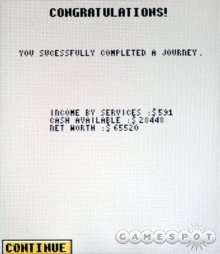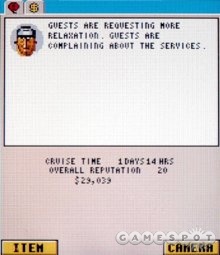Tycoonery reaches new ground (via the ocean floor) with Cruise Ship Tycoon, a simulator that lets you customize and then populate a luxury cruiseliner in search of both monetary and reputation-based rewards. Although the concept is a decent one, as long as you're a fan of corporate megadynasties, the strategy in Cruise Ship Tycoon is almost nonexistent. You can buy and sell all kinds of cool gadgets for your ship, but there's no logic involved in the guest complaints, and the game simply needs more options. Tycoon games succeed only when the strategy involved is rich, and since it isn't here, Cruise Ship Tycoon fails thoroughly.

You begin the game with a fairly large ship and $50,000. The first thing to do in the game is equip your ship with staterooms, facilities, eateries, and entertainment. With the money you have, you can hook your ship up fairly well in the beginning, especially if you're willing to start off with only a few passengers and build more accommodations later on. Once you've done your shopping, the next task is to pick a destination. You can cruise in the Caribbean, Mexican East (which goes from New Orleans to Cozumel), Mediterranean, or the Hawaiian Islands. The cruises range from two days to a week, based on where you're going, but otherwise the destinations seem to have no bearing on the game.
The next step is booking the cruise. The number of people who come aboard is automatically (and randomly) determined, based on how many rooms you have. It seems like reputation should play a role here, but even if your reputation goes up and you don't get more rooms, you'll almost never fill all of the rooms you have. In fact, without significant changes to your ship, you'll probably pull in the exact same number of cruisers every single time you leave port. This is one example of where the game could have used more strategic depth. During all of these planning screens, an icon of the ship at the top of the screen shows how much of it is devoted to lodging, food, and entertainment. After a certain point, you will be physically forced to stop building because there's no room for your intended service, although you can always sell and buy anything on the ship.
After setting sail, you can switch back and forth between a few screens. The status screen indicates a few statistics, like how much money you're making throughout the cruise. You can also switch to camera mode, which shows a primitive picture of the deck, filled with patrons who might or might not have bubbles over their heads indicating what their needs are. The most important screen is the text box that fills up with their complaints. It is important to keep your guests happy by having more facilities than they could possibly use, but even when you do that, the things they ask for often make no sense. A boat with 12 passengers and three bars might request more bars, which is absurd, given how much space a bar takes up. Sometimes the requests are totally nebulous, such as, "I have been waiting for more than two hours," which tells you nothing about what service you're lacking. Ships packed full of pools, arcades, and bars will still have people asking for more entertainment, and there's no immediate correlation between a patron's "stress" and whatever might be causing it.

The graphics in the game aren't great on the LG VX7000. The text, which you'll be dealing with extensively, is clumped into large paragraphs and is filled with typos. The camera, which gives you the only view of the game outside of text boxes and stat windows, shows a few Lego-shaped people milling about on an average-looking deck. The sound is nice for a while, composed of a short steel drum riff that is quite reminiscent of the Caribbean, but after a short period of time, the quick loop will get repetitive, and since it has no bearing on the game other than mood, there's no reason to play it.
If you could work more directly with complaints in Cruise Ship Tycoon, find additional services for your ship, and upgrade more thoroughly, then there might be enough strategy in this game to merit playing it. As it is, your only reward is a worldwide leaderboard already covered with people who have over a billion dollars. Your time would be better spent saving up for a real cruise than playing this game.